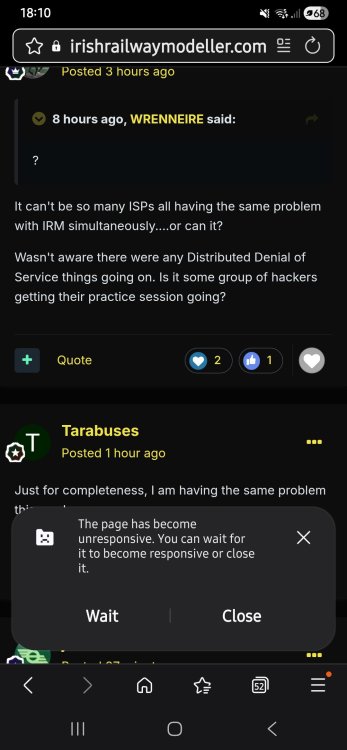-
Posts
2,296 -
Joined
-
Last visited
-
Days Won
4
Content Type
Profiles
Forums
Events
Gallery
Everything posted by Horsetan
-
...with the fada in the right places...
-
Could be worse. Could be horses.....
-
Murphy 141 buffer replacement - has anyone done it?
Horsetan replied to Mol_PMB's question in Questions & Answers
I'd be in the market for a few sets. You never know when they might come in handy.... -
"Voiding the Warranty" - Mol's experiments in 21mm gauge
Horsetan replied to Mol_PMB's topic in Irish Models
You might want to use the correct set as masters for casting further sets of buffers..... -
Even the Notification drop-down list is taking an age....
-
Slowing down again here....
-
Something tells me yer man hasn't been to Confession in a long while....
-
OK so, seems to have reverted to normal speed....for now.
-
-
It can't be so many ISPs all having the same problem with IRM simultaneously....or can it? Wasn't aware there were any Distributed Denial of Service things going on. Is it some group of hackers getting their practice session going?
-
If it is ISP, then it must be affecting a few, as mine's quite slow to make a connection to anything on IRM now.
-
Dunno what route the container ships normally take, but as long as they don't get targeted by Houthi rebels, Somali pirates, Israeli jets, leftover Katyusha rockets or stray Russian-Iranian drones, March/April '26 will be grand.
-
Let me get back to ye on that.
-
We haven't had this year's bonus yet
-
I was about to say.....if it were Q4 in 2026, it would allow some of us more time to save money.....
-
I prefer to work in metal wherever possible.
-
....and I think I can stretch to a GNR(I) "JT" as well, seeing as no.93 survives in Cultra. This may turn out to have the same result, but it is what it is.
-
Leave the card out in direct sunlight for a few months; sure you'll get a fierce UV-fade out of it! No, but private individuals can.
-
mgwr preserved railway Connemara Railway project.
Horsetan replied to ttc0169's topic in What's happening on the network?
We don't know whether it is, or if it might be the electrics going wrong..... -
Do they already have drawings, or do you have to supply?
-
J30, please
-
All the more reason to model it. By 1963, of course, some photos suggest it had gone black rather than weathered grey....
- 37 replies
-
- 1
-

-
- o gauge layout
- irish outline
- (and 2 more)
-
Anyone fancy a go at Sambo?
-
Both the Bachmann and IRM coaches are finished in green, and represent Mk2s. The RPSI coaches that were finished in blue and white are Cravens.
-
More like a "retired" 'RA member trying to remember where he buried one of the Disappeared.
.png.c363cdf5c3fb7955cd92a55eb6dbbae0.png)



